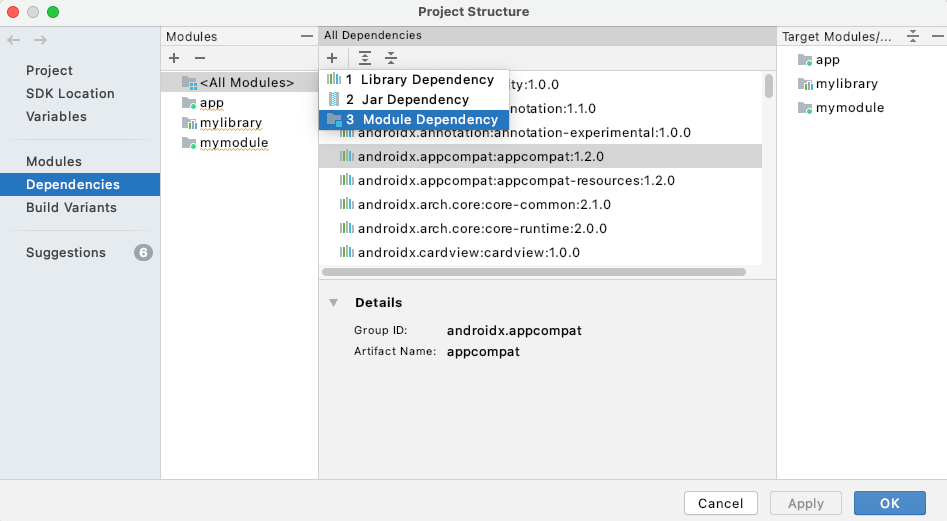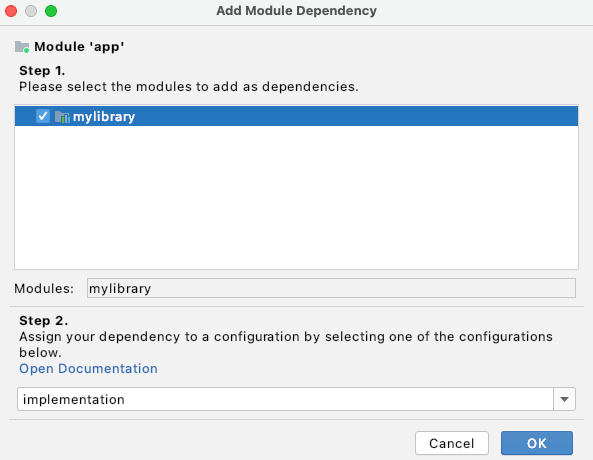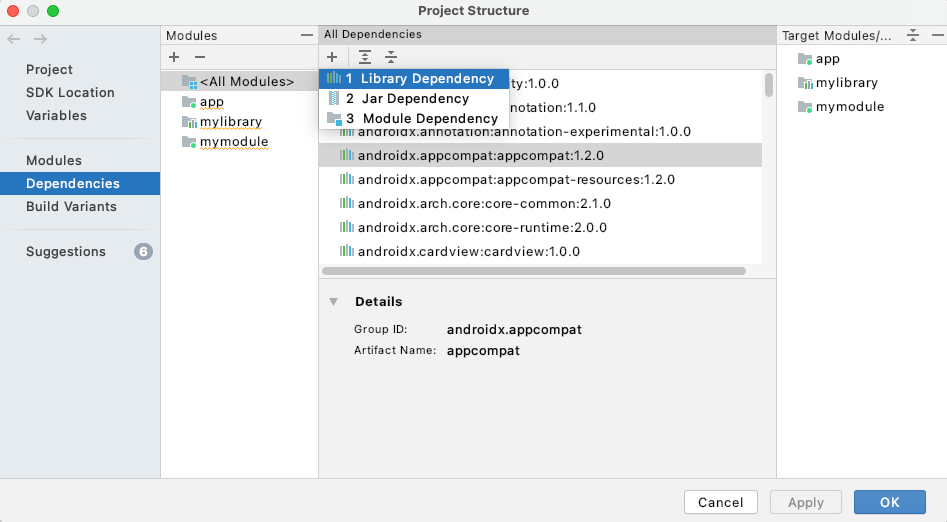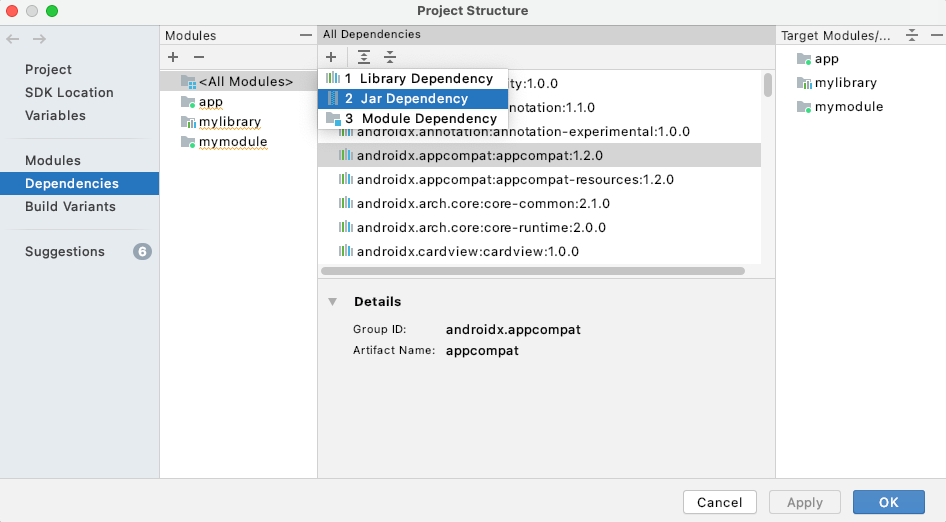Can Not Upload Full Project From Android Studio
An Android library is structurally the same every bit an Android app module. It tin can include everything needed to build an app, including source code, resource files, and an Android manifest. However, instead of compiling into an APK that runs on a device, an Android library compiles into an Android Archive (AAR) file that you can use as a dependency for an Android app module. Unlike JAR files, AAR files offer the following functionality for Android applications:
- AAR files can contain Android resources and a manifest file, which allows you to parcel in shared resource like layouts and drawables in addition to Java classes and methods.
- AAR files tin can incorporate C/C++ libraries for use past the app module's C/C++ code.
A library module is useful in the following situations:
- When you lot're building multiple apps that utilize some of the same components, such as activities, services, or UI layouts.
- When yous're building an app that exists in multiple APK variations, such every bit a complimentary and paid version and you lot need the same core components in both.
In either case, simply motion the files you want to reuse into a library module and so add the library as a dependency for each app module. This folio teaches you how to do both.
Create a library module
To create a new library module in your project, go along as follows:
- Click File > New > New Module.
- In the Create New Module window that appears, click Android Library, so click Next.
In that location'due south also an option to create a Java Library, which builds a traditional JAR file. While a JAR file is useful for many projects— especially when you want to share code with other platforms—it does not allow you to include Android resources or manifest files, which is very useful for code reuse in Android projects. So this guide focuses on creating Android libraries.
- Give your library a name and select a minimum SDK version for the code in the library, and then click Finish.
In one case the Gradle project sync completes, the library module appears in the Project panel on the left. If you don't see the new module folder, make sure information technology'south displaying the Android view.
Catechumen an app module to a library module
If you have an existing app module with all the code you want to reuse, you can turn information technology into a library module as follows:
- Open the module-level
build.gradlefile. - Delete the line for the
applicationId. Merely an Android app module can define this. - At the top of the file, you should encounter the post-obit:
Keen
plugins { id 'com.android.application' }Kotlin
plugins { id("com.android.awarding") }Alter it to the following:
Neat
plugins { id 'com.android.library' }Kotlin
plugins { id("com.android.library") } - Save the file and click File > Sync Project with Gradle Files.
That'south it. The entire structure of the module remains the same, merely it now operates as an Android library and the build will at present create an AAR file instead of an APK.
When you want to build the AAR file, select the library module in the Projection window and then click Build> Build APK.
Adding dependencies with the Project Structure Dialog
Use your library from within the same project
To use your new Android library's code in another app or library module within the same project, add together a project-level dependency:
- Navigate to File> Project Structure> Dependencies.
- Select the Module in which you'll apply the library.
- In the Declared Dependencies tab, click
 and select Module Dependency in the dropdown.
and select Module Dependency in the dropdown. 
-
In the Add Module Dependency dialog, select your library module.

-
Select the configuration that requires this dependency, or select "implementation" if information technology applies to all configurations, and click OK.
Studio will edit your modules's build.gradle file to add the dependency of the course:
implementation(projection(path: ":example-library"))
Employ your library in other projects
The recommended style to share dependencies (JARs and AARs) is with a Maven repository, either hosted on a service such as Maven Central or with a directory construction on your local disk. For more data on using Maven repositories, see Remote repositories.
When an Android library is published to a Maven repository, metadata is included and so that the dependencies of the library are included in the consuming build, which allows the library to be automatically deduplicated if information technology is used in multiple places.
To use your Android library's lawmaking in another app module, proceed every bit follows:
- Navigate to File> Project Structure> Dependencies.
- In the Declared Dependencies tab, click
 and select Library Dependency in the dropdown.
and select Library Dependency in the dropdown. 
-
In the Add Library Dependency dialog, employ the search box to find the library to add together. This form searches the repositories specified in the in the
dependencyResolutionManagement { repositories {...}}cake in thesettings.gradlefile.
-
Select the configuration that requires this dependency, or select "implementation" if information technology applies to all configurations.
-
Check your app's
build.gradlefile to ostend a annunciation similar to the following (depending on the build configuration you've selected):
implementation 'com.example:examplelibrary:one.0.0' Add together your AAR or JAR as a dependency
To use your Android library's code in some other app module, proceed as follows:
- Navigate to File> Project Structure> Dependencies.
- In the Declared Dependencies tab, click
 and select Jar Dependency in the dropdown.
and select Jar Dependency in the dropdown. 
-
In the Add together Jar/Aar Dependency dialog, commencement enter the path to your
.aaror.jarfile, then select the configuration to which the dependency applies. If the library should exist bachelor to all configurations, select the "implementation" configuration.
-
Check your app's
build.gradlefile to confirm a declaration similar to the post-obit (depending on the build configuration you've selected):implementation files('my_path/my_lib.aar')
Alternatively, if you're running Gradle builds exterior of Android Studio, information technology'southward possible to import a dependency past adding a path to the dependency in your app's build.gradle file. For example:
dependencies { implementation fileTree(dir: "libs", include: ["*.jar", "*.aar"]) ... } For more than about adding Gradle dependencies, see Add build dependencies.
Choose resource to make public
All resources in a library default to public. To make all resources implicitly private, you must define at to the lowest degree ane specific attribute as public. Resource include all files in your projection'south res/ directory, such as images. To prevent users of your library from accessing resource intended only for internal utilise, yous should apply this automatic private designation mechanism by declaring one or more than public resources. Alternately, you tin make all resources private by adding an empty <public /> tag , which marks aught every bit public, which makes everything else (all resource) private.
To declare a public resource, add together a <public> declaration to your library's public.xml file. If you haven't added public resources before, you demand to create the public.xml file in the res/values/ directory of your library.
The following instance code creates 2 public string resources with the names mylib_app_name and mylib_public_string:
<resources> <public name="mylib_app_name" blazon="string"/> <public proper noun="mylib_public_string" type="string"/> </resources>
You lot should make public any resources that y'all want to remain visible to developers using your library.
Implicitly making attributes private not only prevents users of your library from experiencing code completion suggestions from internal library resources simply besides allows you to rename or remove private resources without breaking clients of your library. Private resource are filtered out of lawmaking completion, and Lint warns you when you try to reference a private resource.
When building a library, the Android Gradle plugin gets the public resource definitions and extracts them into the public.txt file, which is and so packaged within the AAR file.
Development considerations for library modules
Every bit you develop your library modules and dependent apps, exist aware of the following behaviors and limitations.
One time you lot have added references to library modules to your Android app module, you lot can set up their relative priority. At build time, the libraries are merged with the app one at a fourth dimension, starting from the lowest priority to the highest.
-
Resource merge conflicts
The build tools merge resource from a library module with those of a dependent app module. If a given resources ID is defined in both modules, the resources from the app is used.
If conflicts occur between multiple AAR libraries, so the resource from the library listed first in the dependencies list (toward the top of the
dependenciescake) is used.To avert resource conflicts for common resource IDs, consider using a prefix or other consistent naming scheme that is unique to the module (or is unique across all project modules).
-
In multi-module builds, JAR dependencies are treated as transitive dependencies
When you add a JAR dependency to a library project that outputs an AAR, the JAR is processed past the library module and packaged with its AAR.
Nonetheless, if your projection includes a library module that is consumed past an app module, the app module treats the library'southward local JAR dependency every bit a transitive dependency. In this case, the local JAR is processed by the app module that consumes it, and non by the library module. This is to speed up incremental builds that are caused by changes to a library'due south lawmaking.
Any Java resources conflicts caused by local JAR dependencies must be resolved in the app module that consumes the library.
-
A library module can depend on an external JAR library
You tin develop a library module that depends on an external library. (for example, the Maps external library). In this case, the dependent app must build against a target that includes the external library (for example, the Google APIs Add-On). Note also that both the library module and the dependent app must declare the external library in their manifest files, in a
<uses-library>chemical element. -
The app module's
minSdkVersionmust be equal to or greater than the version defined by the libraryA library is compiled as part of the dependent app module, and then the APIs used in the library module must be uniform with the platform version that the app module supports.
-
Each library module creates its own R class
When you lot build the dependent app modules, library modules are compiled into an AAR file then added to the app module. Therefore, each library has its own
Rclass, named according to the library's bundle name. TheRclass generated from main module and the library module is created in all the packages that are needed including the main module'due south packet and the libraries' packages. -
A library module may include its own ProGuard configuration file
If y'all have a library project that you use to build and publish an AAR, you can add a ProGuard configuration file to your library'due south build configuration and the Android Gradle plugin applies the ProGuard rules that you accept specified. The build tools embed this file within the generated AAR file for the library module. When you add the library to an app module, the library's ProGuard file gets appended to the ProGuard configuration file (
proguard.txt) of the app module.By embedding a ProGuard file in your library module, you ensure that app modules that depend on your library practice not have to manually update their ProGuard files to utilize your library. When the Android Studio build arrangement builds your app, it uses the directives from both the app module and the library. So, there'south no need to run a code shrinker on the library in a carve up step.
To add together the ProGuard rules to your library project, you must specify the file's proper noun with
consumerProguardFilesproperty, inside thedefaultConfigblock of your library'due southbuild.gradlefile. For case, the following snippet setslib-proguard-rules.txtas the library'due south ProGuard configuration file:Groovy
android { defaultConfig { consumerProguardFiles 'lib-proguard-rules.txt' } ... }Kotlin
android { defaultConfig { consumerProguardFiles("lib-proguard-rules.txt") } ... }Nevertheless, if your library module is a role of a multi-module build that compiles into an APK and does not generate an AAR, y'all should run lawmaking shrinking on only the app module that consumes the library. To acquire more well-nigh ProGuard rules and their usage, read Compress, obfuscate, and optimize your app.
-
Testing a library module is the same as testing an app
The primary difference is that the library and its dependencies are automatically included as dependencies of the test APK. This means that the examination APK includes non only its own code, simply as well the library's AAR and all its dependencies. Because there is no divide "app under test," the
androidTesttask installs (and uninstalls) only the test APK.When merging multiple manifest files, Gradle follows the default priority order and merges the library'south manifest into the test APK's principal manifest.
Anatomy of an AAR file
The file extension for an AAR file is .aar, and the Maven antiquity type should be aar as well. The file itself is a null file. The merely mandatory entry is /AndroidManifest.xml.
Additionally, an AAR file may include one or more of the post-obit optional entries:
-
/classes.jar -
/res/ -
/R.txt -
/public.txt -
/assets/ -
/libs/name.jar -
/jni/abi_name/name.so(where abi_name is one of the Android supported ABIs) -
/proguard.txt -
/lint.jar -
/api.jar -
/prefab/for exporting native libraries
weathersficip1989.blogspot.com
Source: https://developer.android.com/studio/projects/android-library
0 Response to "Can Not Upload Full Project From Android Studio"
Post a Comment